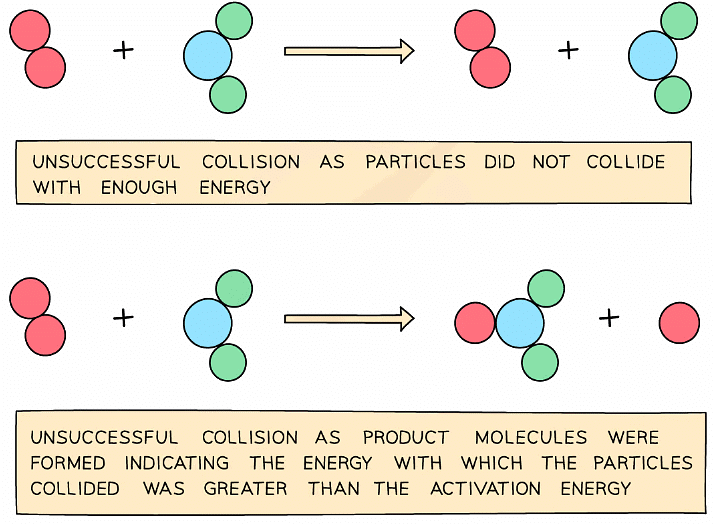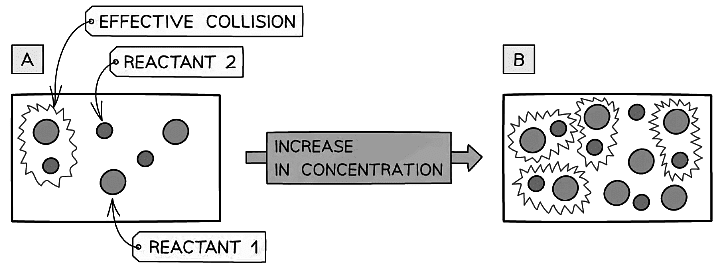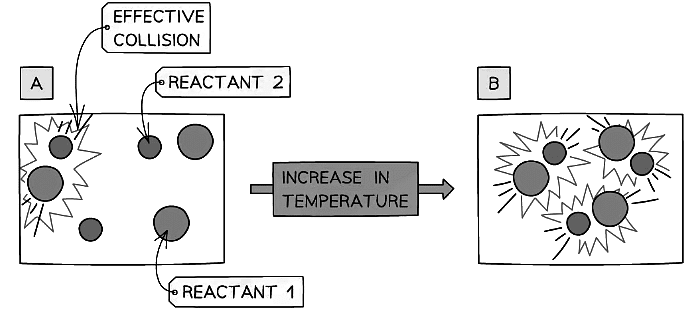Collision Theory & Activation Energy | Chemistry for Grade 10 PDF Download
Collision Theory
- Collision theory states that chemical reactions occur only when the reactant particles collide with sufficient energy to react
- The minimum amount of energy needed is called the activation energy, which is different for each reaction
- Particles that collide with insufficient energy have unsuccessful collisions and just bounce off each other
- The rate of a reaction is therefore also dependent on the energy of collisions as well as the number of collisions
- To increase the rate of a reaction then the number of successful collisions needs to be increased
 Diagram showing a successful and an unsuccessful collision
Diagram showing a successful and an unsuccessful collision
Explaining Rates
- Increasing the number of successful collisions means that a greater proportion of reactant particles collide to form product molecules
- We have seen previously that the following factors influence the rate of reaction
- Increasing concentration / pressure
- Increasing temperature
- Increase the surface area of a solid reactant
- Use of a catalyst
- We can use collision theory to explain why these factors influence the reaction rate:
Concentration of a Solution / Pressure of a Gas
 The diagram shows a higher concentration of particles in (b) which means that there are more particles present in the same volume than (a) so the number of collisions between reacting particles is increased causing an increased rate of reaction
The diagram shows a higher concentration of particles in (b) which means that there are more particles present in the same volume than (a) so the number of collisions between reacting particles is increased causing an increased rate of reaction
Explanation:
- Increasing the concentration of a solution will increase the rate of reaction
- This is because there will be more reactant particles in a given volume, allowing more frequent and successful collisions per second, increasing the rate of reaction
- For a gaseous reaction, increasing the pressure has the same effect as the same number of particles will occupy a smaller space, increasing the concentration
- If you double the number of particles you will double the number of collisions per second
- The number of collisions is proportional to the number of particles present
Temperature
 An increase in temperature causes an increase in the kinetic energy of the particles. The number of successful collisions increases
An increase in temperature causes an increase in the kinetic energy of the particles. The number of successful collisions increases
Explanation:
- Increasing the temperature will increase the rate of reaction
- This is because the particles will have more kinetic energy than the required activation energy
- Therefore there will be more frequent collisions and a higher proportion of particles have energy greater than the activation energy
- This causes more successful collisions per second, increasing the rate of reaction
- The effect of temperature on collisions is not so straightforward as concentration or surface area; a small increase in temperature causes a large increase in rate
- For aqueous and gaseous systems, a rough rule of thumb is that for every 10 oC increase in temperature, the rate of reaction approximately doubles
Surface area of a solid
 An increase in surface area means more collisions per second
An increase in surface area means more collisions per second
Explanation:
- With an increase in the surface area of a solid reactant, the rate of reaction will increase
- This is because more surface area of the particles will be exposed to the other reactant, producing a higher number of collisions per second
- If you double the surface area you will double the number of collisions per second
Exam Tip
Temperature affects reaction rate by increasing the number of collisions and the energy of the collisions. Of the two factors, the increase in energy is the more important one.
|
75 videos|131 docs|24 tests
|




















